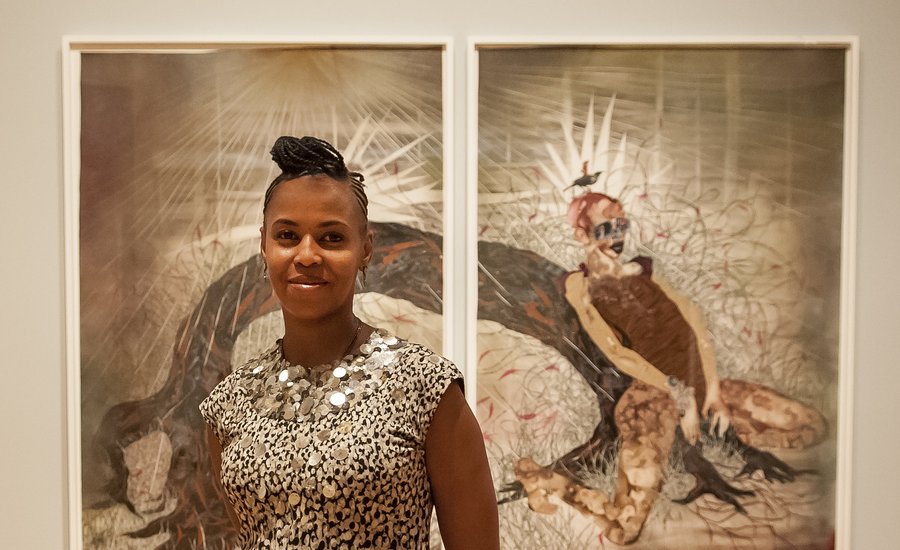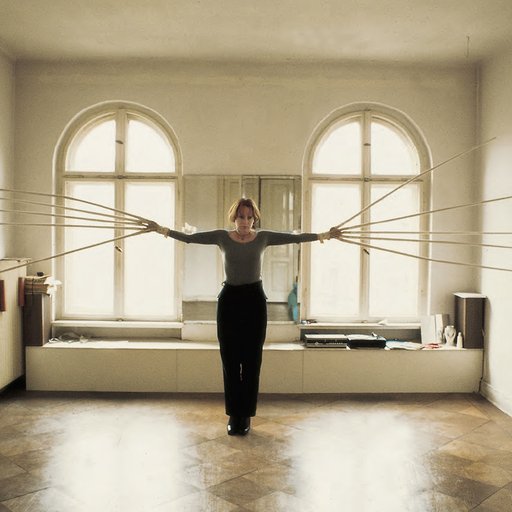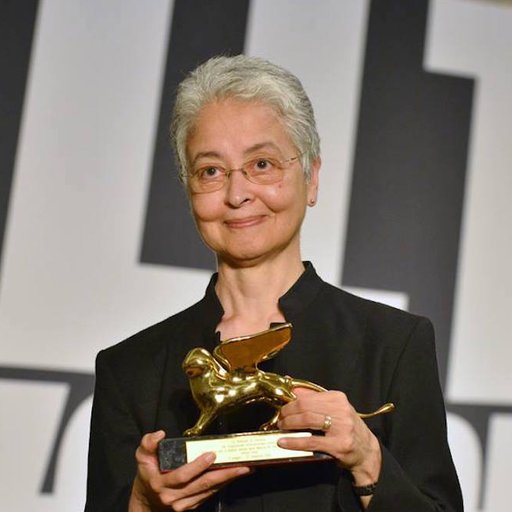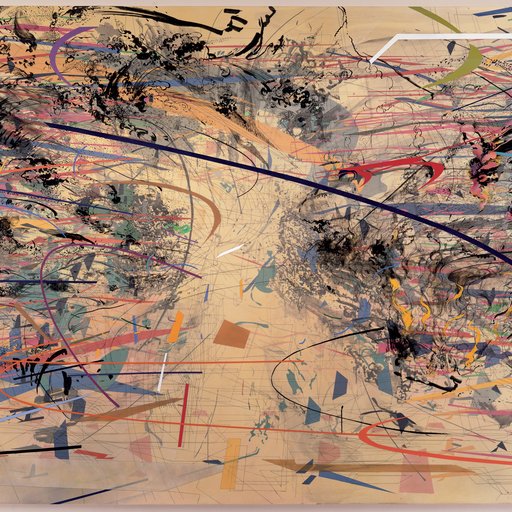In this excerpt from Phaidon’s Akademie X, the celebrated Kenyan painter and collagist Wangechi Mutu gives her best advice for artists struggling to find their voice or achieve recognition, plus her list of must-read literature.
Click here to watch our visit to Wangechi Mutu's studio.
My belief is that art belongs to everyone and that everyone is capable of making art. Some people may be more driven, more gifted, more interested in being artists, but art is one of those shared experiences that anyone from anywhere can actually feel, believe and enjoy. This notion that art is for people with an art education, or that art is for those who are specifically trained to look at it, is not something that I find true.
Secondly, I think that art can be made with virtually anything, so I don’t believe you have to be in a particular kind of economy, cultural context, or a unique space, or have specific items available with which to make art. People who are creative can make art wherever they are. In that sense, I think art is one of the most egalitarian and democratic forms of expression.
When I first started my career, my biggest misconception about the life of a professional artist was that there was a structure that each artist could fit into, with mentors and a community, and that these things would be afforded to me once I began working. In actual fact, there wasn’t any such thing. There were many discussions among my peers about the lack of mentorship, the lack of people to look up to. The blueprint that we all thought existed for older artists wasn’t actually available to us, not only because each and every artist is different, but also because artists aren’t inherently as generous as you might think—especially when there are very few resources to go around. We realized, in the process of moaning about and discussing these things, that you actually have to build these missing communities yourself. You have to learn everything from scratch. You have to create exactly the kind of professional artist you want to be, if indeed that is what you want to do, and understand that being an artist doesn’t necessarily mean that you are capable of being a professional. You have to invent and construct your own ecosystem by which you create and operate, your own teams, your own mannerisms, and these have to do with the kind of person you are. My misconception was that there is one pattern, when in fact, there are as many patterns as there are artists.
If I could go back in time, I would tell my younger self that everything is basically going to be OK. I was an incredibly anxious and nervous person, wondering whether I was going to survive New York; whether I was going to be able to create and be a successful practicing artist, which was always my big dream. Now, I would just tell myself to chill out, be loving, and calm down about everything—it will be alright. I would also have reminded myself that I hadn’t got to the point where I was emerging as an artist by chance; that I’d worked tremendously hard and made a lot of good decisions to arrive where I was. Instead of allowing my confidence to get chipped slowly away by the various problems that one encounters in life, I would have kept on reminding myself, “Wangechi, you’re going to do really well because you have what it takes and you’ve already brought yourself to this point. That’s what made you take the journey from home all the way to New York City.”
The sharpening of visual intelligence is crucial for artists. I would recommend drawing—and by this, I don’t mean drawing in a pedantic, high-school, instructional manner; I mean using your hand and your mind to pull out information from the subconscious onto a surface and into the real world. It is one of the best ways to shorten the distance between your brain and your fingertips and to allow you to gauge what is going on from within yourself. When you speed up that process, by drawing with as basic a material as pencil or charcoal, or ink and brush, your senses of intuition, honesty and integrity are sharpened.
I would also push every artist to enhance their sense of context and their role as artists by visiting museums or the theatre, going to poetry readings, hanging out at DJ slams, listening to live bands—to participate in and enter cultural spaces in one way or another. Figuring out what’s happening in other genres and media in your particular moment in time is important to you as a visual artist because even if you don’t feel it’s relevant to you, making cross-references makes you aware of your own position and place, your aliveness at that particular moment in time.
Everyone should understand as much about the past as they can possibly get in their heads. As the voices of their culture and their communities, artists in particular should know as much as possible about what has happened prior to their own existence. It’s a way to stand out as the voice of the present, to pay homage to what has happened, and avoid repeating and recycling the mistakes that have already been made. It’s also a way of remaining in touch with your own humanity, and with the humanity of others whom you don’t know.
My simplest advice for navigating the art market is never to operate from a place of desperation, and never undervalue yourself. Always acknowledge your position in the food chain: artists are the ones who are transforming and creating and taking risks, in whichever medium they are working. So, in any professional context, never see yourself as a thing in need of salvation. Always insist on your inherent value and distinct role. They eat because you grow the food.
Assigned Reading
Any work by Chinua Achebe
Achebe's work has cut a decisive line through the experiences of an African psyche, all the way from the time before European colonization through to our predicament today, describing in the most palpable language our experience of being taken over and then having to redefine our new selves. Start with No Longer at Ease, and then you must read Things Fall Apart.
Danticat, Edwidge. Krik? Krak! New York: Soho Press, 1991.
Danticat is one of the most perfect writers about those difficult, complicated, and poetic experiences of being from a “somewhere else” that is always maligned and mis-spoken of. Demystifying and rewriting humanity by talking about singular characters and their intensely multilayered lives, Krik? Krak! is a wonderful set of stories that is packed with the massiveness of being Haitian, being a woman, being an immigrant, and being magical.
Haraway, Donna. “A Cyborg Manifesto: Science, Technology, and Socialist-Feminism in the Late Twentieth Century.” In Simians, Cyborgs, and Women: The Reinventionof Nature. New York: Routledge, 1991.
This is my favorite literary button, which says, “The future is female.” With technology driving us faster through time, “A Cyborg Manifesto” makes for an incredible introduction to Haraway's thinking, work, and insight on the female as a radically redefined entity. We also get a glimpse into the author's argument against any essentialism of femaleness: “There is nothing about being female that naturally binds women together into a unified category.” Haraway fights any inclination to categorize women from a traditional and singular position. As a creator myself of mythological hybrid beings that defy categories and power, I so enjoyed this text!
Tate, Greg. Flyboy in the Buttermilk: Essays on Contemporary America. New York: Simon & Schuster, 1992.
If you're a contemporary artist and want to operate from a space of awareness and cultural alertness, Greg Tate's writing is a must. These essays help make you savvy about you how art-making, and any cultural production, is brewed in the big steamy pot of social, cultural, political, and racial issues.
Wainaina, Binyavanga. “How to Write About Africa,” Granta, Issue 92. 2005.
What a powerful way to describe growing up in Kenya. If I hadn't grown up there, I'd want to visit and see it, embedded in Binyavanga's world. It's a story about just one guy, but it's also a story about one little country—how it's grown with him and how he makes it matter to everyone.
Wallace, Michelle. Black Macho and The Myth of The Superwoman. New York: The Dial Press, 1978.
If you're curious about how issues of women's empowerment exist adjacent to Black masculinity, and you're operating as a conscious, female creative type, this publication is for you.
READ MORE FROM AKADEMIE X ON ARTSPACE:
6 Art-World Lessons From the Unorthodox Classroom of Akademie X
Chris Kraus on the Ambiguous Virtues of Art School
Words to Live By: Marina Abramović's Mystical Maxims for Artists
Venice Biennale Representative Joan Jonas's Workout Regimen for Artists
The Four-Hour Art Week? Read Carol Bove's Self-Help Guide for Artists
Sanford Biggers’s Tough-Love Guide to Surviving the Art World
Go On a New York City Scavenger Hunt With Artist Mark Dion
Ólafur Elíasson’s 9 Foolproof Tips for Urban Inspiration
Painter Carrie Moyer on Her Polyamorous Relationship With Art



























